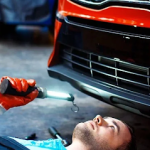When you’re part of the world of track racing, every component of your car matters. The performance of your vehicle doesn’t just rely on its engine or driver’s skills. The wheels, specifically, can impact your track performance significantly. Among the important parts of your wheels are the studs. The studs are essential components that secure your car’s wheels, helping transmit the torque from the drive shaft to the wheels during a race. If they fail, it could lead to disastrous consequences on the track. Therefore, regular inspection and replacement is imperative. But exactly how often should the wheel studs be inspected and replaced? Let’s delve into this issue.
The Role of Wheel Studs in Track Racing
Before we delve into the frequency of inspection and replacement of wheel studs, let’s understand their function. Wheel studs, or lug studs, are bolts that are permanently mounted on the wheel hub assembly of your car. They are crucial as they secure the wheels to the car’s hub. When you tighten the lug nuts onto these studs, the wheel becomes secured to the hub assembly, ensuring a seamless transfer of torque from the engine to the wheels.
Also to read : How should you test and maintain active yaw control systems in performance vehicles?
The wheel studs are exposed to considerable stress, especially during track racing. They have to bear the car’s weight, the forces from the engine’s torque, and the additional forces from high-speed driving, corners, and sudden braking. Thus, they are susceptible to wear and tear and need regular check-ups.
The Importance of Regular Stud Inspection
Having established the critical role of studs in your vehicle’s performance, regular inspection becomes an essential part of your vehicle maintenance. Regularly checking your wheel studs can help you identify early signs of wear and tear. For instance, you might notice thread damage in some of your studs, or perhaps some studs might be loose.
Topic to read : What are the safety protocols for handling and disposing of electric vehicle components post-accident?
Loose or damaged studs can compromise wheel stability, which can be a serious safety hazard, especially in a high-speed sport like track racing. Hence, if you notice abnormalities during your inspection, it’s time to replace these studs.
The Frequency of Stud Inspection and Replacement
The frequency of stud inspection and replacement largely depends on the car’s usage. Vehicles used for regular city drives may require inspection once every 12 months, while those used for track racing need more frequent checks.
Generally, it’s recommended that wheel studs in cars used for track racing be inspected after every track day, or after every 5,000 miles driven, whichever comes first. However, this is a general guideline and doesn’t account for factors such as the car’s age, the quality of the studs, and the driving conditions of the track.
If the studs are of poor quality or if they are exposed to harsh driving conditions, they may need to be inspected more frequently. In such cases, you might want to consult with a professional or experienced track racer to get a more accurate estimate.
Replacing Worn-out Wheel Studs
If during your inspection, you notice that a stud is damaged, it’s essential to replace it immediately. How you’ll know a stud is damaged could be through visible signs like stripping of the threads or rusting. Sometimes, the studs may be loose or even missing – clear indicators that a replacement is necessary.
When replacing wheel studs, it’s generally recommended to replace all the studs on that wheel at the same time. This is because if one stud is worn out, the others are likely to be in a similar condition.
Moreover, it’s crucial to use high-quality, race-grade studs that can withstand the rigours of track racing. They may be more expensive, but the enhanced safety and performance they provide make them a worthwhile investment.
In conclusion, the health of your wheel studs is an often overlooked, yet critical aspect of car maintenance, particularly for those involved in track racing. Regular inspections and prompt replacements not only ensure that your car performs optimally on the track, but they also contribute crucially to your safety.
Expert Tips for Wheel Stud Maintenance
Maintaining your wheel studs in optimal condition is a crucial part of vehicle upkeep, especially for track racing vehicles. Here, we share expert tips that could be beneficial for drivers.
Firstly, when inspecting your wheel studs, you should ideally use a torque wrench. This tool will allow you to accurately gauge the tightness of your lug nuts. Remember that overtightening can lead to stud damage, while loose lug nuts can cause the wheel to wobble or even come off during a race.
Secondly, when replacing your wheel studs, always opt for quality over cost. Cheap, low-quality studs might save you money upfront, but they are more likely to fail under high-stress conditions. Consider opting for race-grade wheel studs, which are designed to withstand the rigours of track racing.
Finally, consider engaging a professional for your wheel stud inspection and replacement needs. As a senior member of the racing community once stated, “The safety and performance of your vehicle hinge on the integrity of your wheel studs. Don’t skimp on professional help.” Indeed, an experienced mechanic or seasoned track racer can provide invaluable insights and help ensure that your studs are in optimal condition.
Conclusion
In the fast-paced, high-stakes world of track racing, even the smallest component of your vehicle can make a significant impact, as is the case with wheel studs. These crucial components bear the brunt of considerable stress and must be inspected and replaced more frequently than in regular city drives.
It’s typically recommended to inspect your wheel studs after every track day, or every 5,000 miles driven. However, factors such as the quality of your studs, the age of your car, and your track conditions also play a role in determining the frequency of checks. If in doubt, it’s always best to consult with an experienced professional or fellow track racer.
Furthermore, the importance of using high-quality, race-grade studs cannot be overstated. Their superior durability and ability to withstand harsh driving conditions make them a worthwhile investment for any track racer.
In summary, wheel stud maintenance is an often-underestimated yet critical aspect of vehicle upkeep, with its importance magnified in the realm of track racing. Regular inspections and prompt replacements can dramatically enhance both your safety and your car’s performance on the track. It’s a small yet significant way to stay ahead in the race.












